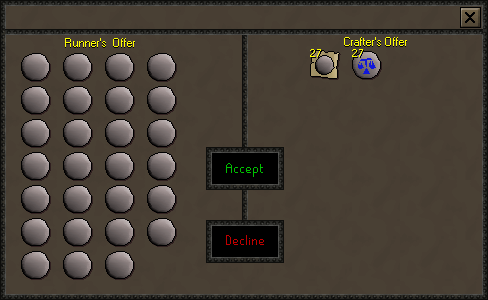“Law Running” in RuneScape, circa 2007


Many in our generation will fondly remember a Java-based massive multiplayer online role-playing game named RuneScape, which reached its peak around 2006 when we were in elementary or middle school, and has been recently reaching a second peak, fueled by a reset of its gameplay and graphics to the 2007 version of the game, and thus the return of many nostalgia-ridden former players, now in their early 20s, to its virtual world.
RuneScape has always been an interesting case where a game gained immense success and a spirited analysis of its economy by players, in spite of its simple graphics and rather repetitive “grinding” gameplay — or perhaps because of it. For example, the game, previously based on barter and individual trades, eventually developed a central trading system called the “Grand Exchange” where all players could buy and sell every item, with the system calculating average prices based on demand. In the spirit of the analogy with stock exchanges (or even because of convergent evolution of needs), the developers even created a database of live prices for items, tracking the average prices of every item in the game over the past 90 days.
Yet, even before the Grand Exchange automated the effective auction system inherent to trading in the game, one special part of life for many RuneScape players was an activity known as “law running”. Law running consisted of low-leveled players making “easy money”, counted in GP (gold pieces), by providing high-leveled players with the raw materials (known as “rune essence”), which the latter crafted into magical “law runes” — the namesake of the game.
Since the law rune altar, a remote part of the map and the only place law runes could be created, was very far from even the nearest bank (where a player could store a large repository of items), high-leveled players often sought a quicker way to gain experience in the Runecrafting skill — by allowing low-leveled players looking for a quick buck to bring them rune essence from their own banks in exchange for crafted law runes. Since law runes were worth much more than rune essence, the “law runner”, as the low-leveled player was known, would make a huge profit, while the runecrafter would be able to gain experience very quickly without losing money (only profit).

Thousands of players would buy or mine rune essence, and hop onto a server unofficially designated by the RuneScape community for law running. There, they would fill their inventory with rune essence and run to the remote part of the map where law rune altar to find a runecrafter they could trade the essence to and receive law runes back.
Quickly, a network with unequal power distribution emerged. There were almost always many more law runners than crafters, so crafters could often get away with giving runners less law runes than the number of rune essence that they were given. Since trades with other players could not occur concurrently, holding out for higher profit could mean loss of time for the runner, since he or she could be on their way back for a second run in the time it took to find another crafter to trade with.
However, although the law running business was a rat race with little unionization, there were times when the urgency of trading could benefit the runner. While the crafter’s “node” had “edges” with many potential runners and the runners each only had an “edge” with one crafter at a time, the only currency that mattered to the high-leveled, wealthy runner was time. During times of low traffic, say at 4 am, crafters could be seen offering not half, but up to three times the regular number of law runes to the runners, in order to build more (strong) edges with runners, becoming their preferred patron.
In this symbiotic relationship, the more well-connected nodes (the law crafters) seemed to have the upper hand because they decided which weak node (the law runners) they would trade with each time; the edges would be the trade offers, limited to one at a time for a runner but as many as came in for the crafter (effectively resulting in a one-exchange network). If more runners came out of the woodwork, frantic to get their cut and return as fast as possible, the crafters would find themselves more connected than usual, able to take more for themselves in every exchange with little loss of time since there would always be another alternative runner to give their business to immediately. However, if less runners were active at a time, the crafters would find themselves with edges to less runners, who were in turn made less weak by the virtue of there being less of them. In these cases, the crafter would have to offer much higher prices in order to maintain a workable schedule, since trade messages came in less often. A crafter’s nightmare, even more so than a runner’s, was waiting for minutes at a time with no runners to provide them with raw materials, while being stuck in a remote part of the map (referred to as “XP waste”, along with sleeping, eating, and schoolwork).
This activity, full of subtle dynamics that occurred between real players in real time, was a brilliant display of how the number of singly-connected “satellite” nodes attached to a single central node determines the relative power of every node in the system, in addition to factors like urgency and a sense of fairness present in most practical manifestations of exchange networks.
https://www.youtube.com/watch?v=TLtIeiOWvAM
http://runescape.wikia.com/wiki/Law_rune_running

Yeah it is so true. Runescape is such a fantastic game it can however be a bit addicting! 😛
Great article man! +1